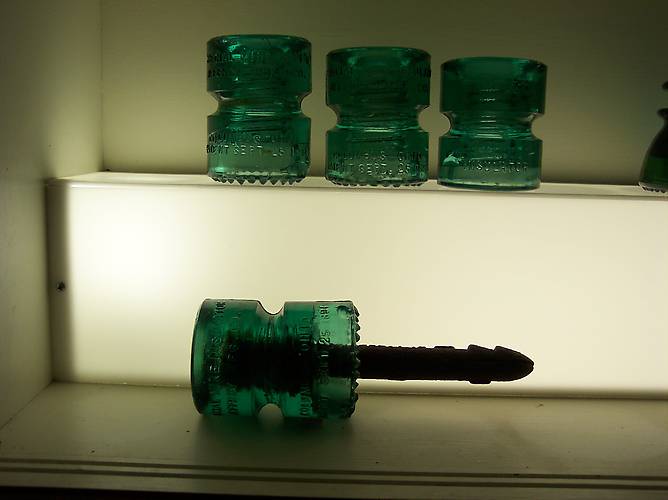CD 185 Height Variance & Drips?
By Michael Gibbons; posted September 15, 2012
View Original: Click to zoom, then click to magnify (2580 x 1932) 578KB

|
I purchased an insulator collection from the Hall family with a box labeled mine insulators. Most of them are simply no embossing 1090 glass spools, but some are actual threaded Jeffrey mine insulators. Is it typical of CD 185's to have such a big variance in height? (3 7/8, 3 5/8, 3 3/8) Also wondering if the sharp drip points and 1894 patent date suggest Hermingray had a hand in producing this product? Also included in the picture is an insulator with its pin, figuring not many people have seen one meant to be hammered into rock. The pin is actually hollow with slits in the side, which acts as a French drain of sorts allowing water to pass through the insulator. From Newcastle, Colorado so they probably came out of a coal mine. ANSWER--A Hemingray product that varies greatly in height. Mine insulators of this type are molded in a sliding cylinder type of mold that allowed the insulator to be bigger or smaller depending on the amount of glass poured into the mold. Other insulators made in a similar fashion include EC&M, Cal Elec's, and CEW's. Michael HISTORICAL NOTE: I do not know them personally, but I would like to mention the Hall family. They where one of the oldest families of insulator collectors in the region, spanning 3 generations from the Newcastle, Colorado area starting in the early 1950's. I purchased the Hall family collection on 9/7/2012, which consisted of thousands of great pieces, like these mine insulators. Russel & Bertha Hall.....Gary R. Hall.....Michael G. Hall.....purchased by Michael Gibbons 9/7/2012 |